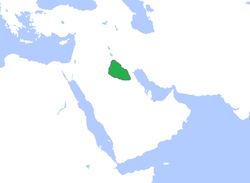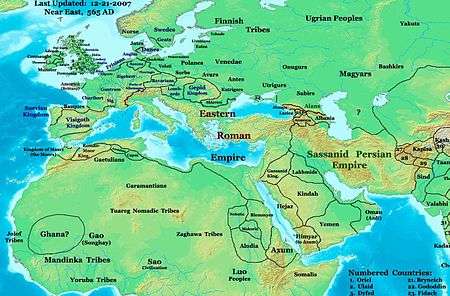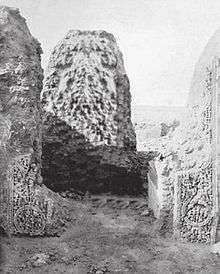Lakhmids
| Lakhmid Kingdom اللخميون | |
|---|---|
| c.300–602 | |
 Map of the Lakhmid kingdom. | |
| Capital | Al-Hirah |
| Common languages | |
| Religion | Christianity (Church of the East) |
| Government | Monarchy |
| History | |
• Established | c.300 |
• Annexed by Sasanian Empire | 602 |
The Lakhmids (Arabic: اللخميون) or Banu Lakhm (Arabic: بنو لخم) were an Arab kingdom of southern Iraq with al-Hirah as their capital, from about 300 to 602 AD. They were generally but intermittently the allies and clients of the Sassanian Empire, and participant in the Roman–Persian Wars.[2]
History


The Lakhmid Kingdom was founded by Banu Lakhm tribe that emigrated from Yemen in the second century and ruled by the Banu Lakhm, hence the name given it. The founder of the dynasty was 'Amr, whose son Imru' al-Qais (not to be confused with the poet Imru' al-Qais who lived in the sixth century) is claimed to have converted to Christianity according to Western authors.
Imru' al-Qais dreamt of a unified and independent Arab kingdom and, following that dream, he seized many cities in the Arabian Peninsula. He then formed a large army and developed the Kingdom as a naval power, which consisted of a fleet of ships operating along the Bahraini coast. From this position he attacked the coastal cities of Iran - which at that time was in civil war, due to a dispute as to the succession - even raiding the birthplace of the Sasanian kings, Fars Province.
In 325, the Persians, led by Shapur II, began a campaign against the Arab kingdoms. When Imru' al-Qais realised that a mighty Persian army composed of 60,000 warriors was approaching his kingdom, he asked for the assistance of the Roman Empire. Constantius II promised to assist him but was unable to provide that help when it was needed. The Persians advanced toward Hira and a series of vicious battles took place around and in Hira and the surrounding cities.
Shapur II's army defeated the Lakhmid army and captured Hira. In this, the young Shapur acted much more violently and slaughtered all the Arab men of the city and took the Arab woman and children as slaves. He then installed Aws ibn Qallam and retreated his army.
Imru' al-Qais escaped to Bahrain, taking his dream of a unified Arab nation with him, and then to Syria seeking the promised assistance from Constantius II which never materialized, so he stayed there until he died. When he died he was entombed at al-Nimarah in the Syrian desert.
Imru' al-Qais' funerary inscription is written in an extremely difficult type of script. Recently there has been a revival of interest in the inscription, and controversy has arisen over its precise implications. It is now certain that Imru' al-Qais claimed the title "King of all the Arabs" and also claimed in the inscription to have campaigned successfully over the entire north and centre of the peninsula, as far as the border of Najran.
Two years after his death, in the year 330, a revolt took place where Aws ibn Qallam was killed and succeeded by the son of Imru' al-Qais, 'Amr. Thereafter, the Lakhmids' main rivals were the Ghassanids, who were vassals of the Sassanians' arch-enemy, the Roman Empire. The Lakhmid kingdom could have been a major centre of the Church of the East, which was nurtured by the Sassanians, as it opposed the Chalcedonian Christianity of the Romans.

The Lakhmids remained influential throughout the sixth century. Nevertheless, in 602, the last Lakhmid king, al-Nu'man III ibn al-Mundhir, was put to death by the Sasanian emperor Khosrow II because of a false suspicion of treason, and the Lakhmid kingdom was annexed.
It is now widely believed that the annexation of the Lakhmid kingdom was one of the main factors behind the fall of the Sasanian Empire and the Muslim conquest of Persia as the Sasanians being defeated in the Battle of Hira by Khalid ibn al-Walid.[3] At that point, the city was abandoned and its materials were used to reconstruct Kufa, its exhausted twin city.
The Battle of Dhi Qar pitted the Arabs of southern Iraq against the Sasanian army around 609.
According to the Arab historian Abu ʿUbaidah (d. 824), Khosrow II was angry with the king, al-Nu'man III ibn al-Mundhir, for refusing to give him his daughter in marriage, and therefore imprisoned him. Subsequently, Khosrow sent troops to recover the Nu'man family armor, but Hani ibn Mas'ud (Nu'man's friend) refused, and the Arab forces of the Sasanian Empire were annihilated at the battle of Dhi Qar, near Hira, the capital of the Lakhmids. Hira stood just south of what is now the Iraqi city of Kufa.
Lakhmid Kingdom facts
- Al-Hirah became the cradle of the Arabic alphabet.
- Poets born in the Kingdom included: al-Nabigha, Laqete ibn Ya'amur al-Ayadi, 'Alqama ibn 'Abada and Adi ibn Zayd. Other great poets visited, like Tarafa and Amr ibn Kulthum (who killed 'Amr III ibn al-Mundhir).
- The military of the Sasanian Empire, along with al-Mundhir III ibn al-Nu'man himself and his army, defeated the famed Roman general Belisarius at the Battle of Callinicum (531).
- After the death of al-Nu'man III, the Arabs defeated the Persians in the Battle of Dhi Qar.
- Bahram V lived in Hira and was educated at the court of al-Mundhir I, whose support helped him gain the throne after the assassination of his father.
Lakhmid dynasty and its descendants
| Historical Arab states and dynasties | ||||||||||||||||||||||||||||||||||||||||||||||||||||||||||||
|---|---|---|---|---|---|---|---|---|---|---|---|---|---|---|---|---|---|---|---|---|---|---|---|---|---|---|---|---|---|---|---|---|---|---|---|---|---|---|---|---|---|---|---|---|---|---|---|---|---|---|---|---|---|---|---|---|---|---|---|---|
 | ||||||||||||||||||||||||||||||||||||||||||||||||||||||||||||
|
Ancient Arab States
|
||||||||||||||||||||||||||||||||||||||||||||||||||||||||||||
|
Eastern Dynasties
|
||||||||||||||||||||||||||||||||||||||||||||||||||||||||||||
|
Western Dynasties
|
||||||||||||||||||||||||||||||||||||||||||||||||||||||||||||
|
Arabian Peninsula
|
||||||||||||||||||||||||||||||||||||||||||||||||||||||||||||
|
Current monarchies
|
||||||||||||||||||||||||||||||||||||||||||||||||||||||||||||
The founder and most of the rulers of the kingdom were from the Banu Lakhm dynasty.
Many modern "Qahtanite" dynasties claim descent from the Lakhmids such as the Mandharis of Oman, Iraq, and the United Arab Emirates, the Na'amanis of Oman, and the powerful Druze Arslan royal family.
Lakhmid rulers
| # | Ruler | Reign |
|---|---|---|
| 1 | 'Amr I ibn Adi | 268–295 |
| 2 | Imru' al-Qays I ibn 'Amr | 295–328 |
| 3 | 'Amr II ibn Imru' al-Qays | 328–363 |
| 4 | Aws ibn Qallam (non-dynastic) | 363–368 |
| 5 | Imru' al-Qays II ibn 'Amr | 368–390 |
| 6 | al-Nu'man I ibn Imru' al-Qays | 390–418 |
| 7 | al-Mundhir I ibn al-Nu'man | 418–462 |
| 8 | al-Aswad ibn al-Mundhir | 462–490 |
| 9 | al-Mundhir II ibn al-Mundhir | 490–497 |
| 10 | al-Nu'man II ibn al-Aswad | 497–503 |
| 11 | Abu Ya'fur ibn Alqama (non-dynastic, uncertain) | 503–505 |
| 12 | al-Mundhir III ibn al-Nu'man | 503/5–554 |
| 13 | 'Amr III ibn al-Mundhir | 554–569 |
| 14 | Qabus ibn al-Mundhir | 569–573 |
| 15 | Suhrab (Persian governor) | 573–574 |
| 16 | al-Mundhir IV ibn al-Mundhir | 574–580 |
| 17 | al-Nu'man III ibn al-Mundhir | 580–602 |
| 18 | Iyas ibn Qabisah al-Ta'i (non-dynastic) with Nakhiragan (Persian governor) | 602–617/618 |
| 19 | Azadbeh (Persian governor) followed by the Muslim conquest of Persia | 617/618–633 |
Al Mandhari / Al Na'amani families
The "Mandhari and Na'amani tribes" are the main descendants of the Lakhmids in the Persian Gulf. They are, for the most part, the same family with superficial, simple differences. The main difference is that the Na'amani family traces its lineage back to al-Nu'man III ibn al-Mundhir while the Mandhari family traces it back to his grandfather: king al-Mundhir ibn Imr'u al-Qais, but a significant number of members of the Al Mandhari tribe are descendants of king al-Nu'man III ibn al-Mundhir. Both families are mainly situated in the Iraq, Yemen, the United Arab Emirates, and the Sultanate of Oman.
Both families are well known for their members engaging in merchantry and judicial responsibilities.
Al Abbadi dynasty
This family in particular descends from the Lakhmids that ruled the historical area of modern day Andalusia: Al-Andalus, known as the Abbadids. Members of this family are restricted to the descendants of the grandfather of powerful Abbabid king, Abu al-Qasim Muhammad ibn Abbad, who is said to be a descendant of the Lakhmid king Al-Nu'man III ibn al-Mundhir, which makes the members of this dynasty members of the Na'amani and Mandhari families by phylogeny.[4] This Dynasty is extinguished in male line with Prince Rashid and Prince Al-Radi that were killed. The most prominent member of the Abbadids was Al-Mu'tamid ibn Abbad, who was the ruler of taifa of Seville, which was the biggest and most illustrious of all Muslim tai'fas of Andalusia. His shrine is in Morocco, particularly in Marrakesh.[5]
In literature
Poets described al-Hira as paradise on earth; an Arab poet described the city's pleasant climate and beauty thus: "One day in al-Hirah is better than a year of treatment". The ruins of al-Hirah are located 3 kilometres (1.9 mi) south of Kufa on the west bank of the Euphrates.
See also
References
- ↑ Tafażżolī, A. "ARABIC LANGUAGE ii. Iranian loanwords – Encyclopaedia Iranica". www.iranicaonline.org. Encyclopedia Iranica. Retrieved 8 February 2017.
Some of the Arab poets of the Lakhmid court, including ʿAdī b. Zayd and Aʿšā, were well versed in Middle Persian and acquainted with Iranian culture.
- ↑ http://www.iranicaonline.org/articles/lakhmids
- ↑ Iraq After the Muslim Conquest By Michael G. Morony, pg. 233
- ↑ http://islamport.com/w/amm/Web/1579/939.htm
- ↑ http://www.alhewar.net/Basket/Habeeb_Salloum_al-mutamid_bin_abbad.htm
Sources
- Bosworth, Clifford Edmund, ed. (1999). The History of Al-Ṭabarī, Volume V: The Sāsānids, the Byzantines, the Lakhmids, and Yemen. State University of New York Press. pp. 370–371. ISBN 978-0-7914-4355-2.
- Martindale, John R.; Jones, A.H.M.; Morris, John (1992), The Prosopography of the Later Roman Empire: Volume III, AD 527–641, Cambridge University Press, p. 258, ISBN 0-521-20160-8
- History book of Ibn Khaldoun
- History book of Ibn al-Athir
- History book of Ibn Hisham
- Rothstein, Gustav (1899), Die Dynastie der Lahmiden in al-Hira. Ein Versuch zur arabisch-persischen Geschichte zur Zeit der Sasaniden (in German), Berlin: Reuther & Reichard
- Britannica Encyclopedia
- Bahrain government website "Arabic website"
- Article about al-Hira history "Arabic website"
External links
- Al Sejel el Arslaneh (the book of the history of the Arslan dynasty)